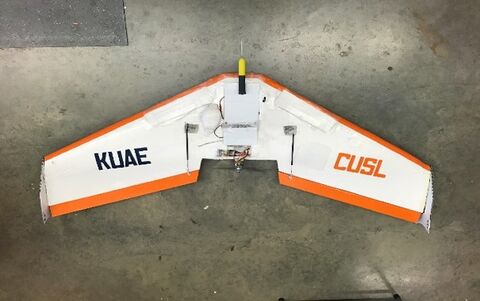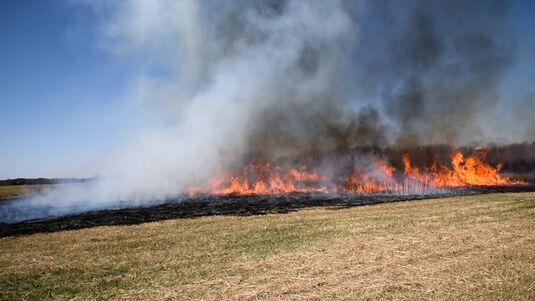UASFireWorkshop2021: Difference between revisions
Chaohaiyang (talk | contribs) No edit summary |
Chaohaiyang (talk | contribs) No edit summary |
||
| (32 intermediate revisions by the same user not shown) | |||
| Line 44: | Line 44: | ||
</html> | </html> | ||
==2021 UAS Integration for Fire Operation Workshop (KU)== | |||
[[file:KHawk55Thermal.jpg|480px|]] | [[file:KHawk55Thermal.jpg|480px|]] | ||
[[file:Fire.jpg| | [[file:Fire.jpg|535px|]] | ||
[[file:Thermal.png|400px|]] | [[file:Thermal.png|400px|]] | ||
---- | |||
===Introduction === | |||
The goal of our workshop is to bring together UAS developers and operators, prescribed fire operators, wildfire fighters, and emergency response agency for idea exchange and discussions on how we can integrate new UAS technology to both wildfire fighting and prescribed fire operations. | The goal of our workshop is to bring together UAS developers and operators, prescribed fire operators, wildfire fighters, and emergency response agency for idea exchange and discussions on how we can integrate new UAS technology to both wildfire fighting and prescribed fire operations. | ||
Time: 8:45 AM – 15:30 PM CDT, 2021/11/17(Wednesday) | |||
Sponsor: USDA-NIFA National Robotics Initiative Grant, NSF Smart & Connected Community Grant | Sponsor: USDA-NIFA National Robotics Initiative Grant, NSF Smart & Connected Community Grant | ||
Contact: Haiyang Chao, Ph.D. & Associate Professor, Aerospace Engineering Department, University of Kansas | |||
---- | |||
===Technical Presentations === | |||
Introduction & Opening (8:45-9:00 CDT), Haiyang Chao, University of Kansas [http://people.ku.edu/~h512c315/UASfireworkshop2021/0_FireUASWorkshop_Opening.pdf (PDF)] | |||
Plenary talk (9:00-9:30 CDT) | |||
“Wildfire-induced cascading geohazards and programming at USDA NIFA for hazards mitigation”, Farshid Vahedifard, Mississippi State University and Steven Thomson, USDA NIFA [http://people.ku.edu/~h512c315/UASfireworkshop2021/1_ThomsonVahedifardUASFireIntegrationWorkshop.pdf (PDF)] | |||
Tech Presentations (9:30-11:00 CDT) | |||
a. 9:30 – 9:45, “Fire metrics measurement using sUAS”, Haiyang Chao, University of Kansas [https://kansas-my.sharepoint.com/:b:/g/personal/m149s910_home_ku_edu/EX_DaJR9XQhLm0xAsUCPMMwBS8I118t4gPXaKwcDIOrSBQ?e=urociz (PDF)] | |||
b. 9:45 – 10:00, “UAS data enabled operational fire spread simulation”, Xiaolin Hu, Georgia State University [http://people.ku.edu/~h512c315/UASfireworkshop2021/3_Hu_NRI_Workshop.pdf (PDF)] | |||
c. 10:00-10:15, “Smoke management for prescribed burning”, Zifei Liu, Kansas State University [http://people.ku.edu/~h512c315/UASfireworkshop2021/4_Liu_Smokeworkshop.pdf (PDF)] | |||
d. 10:15-10:30, “Reasons for conducting a prescribed Burn”, Walter Fick, Kansas State University [http://people.ku.edu/~h512c315/UASfireworkshop2021/5_FickBurnObj.pdf (PDF)] | |||
e. 10:30-10:45, “Prescribed fire setting using multi-rotor UAS”, Carrick Detweiler, University of Nebraska, Lincoln and Drone Amplified [http://people.ku.edu/~h512c315/UASfireworkshop2021/6_DroneAmplified-KU-Fire-20211116.pdf (PDF)] | |||
f. 10:45-11:00, “sUAS data sharing guidelines”, Lindsay Barbieri, Earth Science Information Partners (ESIP) [http://people.ku.edu/~h512c315/UASfireworkshop2021/7_BarberiESIPsUASDataSharingGuidelines.pdf (PDF)] | |||
---- | |||
===Discussions === | |||
'''UAS for Wildfire Operation Discussion''' (11:00-12:30 CDT) – Moderator: Haiyang Chao and Sheena Parsons | |||
Objective: UAS safety and wildfire integration challenges/needs | |||
Survey Question 1 (results in ''italic''): What are the most critical challenges for integration of small UAS into wildfire surveillance? | |||
1. ''UAS and crew safety;'' | |||
2. UAS capability to handle wind and turbulence; | |||
3. ''Available information UAS can deliver,'' | |||
4. UAS endurance, weight and size, | |||
5. ''Dynamically changing fire environments; '' | |||
6. FAA regulation; | |||
7. Other | |||
Survey Question 2: What is the biggest safety concern for you to use UAS in your fire operations? | |||
''1. Strong wind and turbulence''; | |||
2. UAS flight over people on the ground; | |||
''3. Avoidance of terrain or other aircraft'' | |||
Survey Question 3: What is the most needed wildfire information that UAS can provide during wildfire fighting? | |||
''1. Fire front location and rate of spread;'' | |||
2. Fire temperature; | |||
3. Hot spot location and temperature; | |||
4. Flame height | |||
Discussion Question 1: | |||
What type of UAS is most needed for wildfire fighting now? Size and weight limit? Sensing capability? Actuation capability (fire ball dropping)? Autonomous capability (fireline following?). Endurance and scale? | |||
Discussion Question 2: | |||
Human UAS interface. How can we speed up the communication between UAS and human operator during the fire fighting? | |||
Discussion Question 3: | |||
What are the needs from the wildfire fighters and government agency for UAS integration? | |||
Discussion Question 4: | |||
How can we build a wildfire resilient community? How can different communities help each other? University, fire fighter, government agency. | |||
Prescribed Fire Community Discussions (13:30-15:00 CDT) – Moderator: Walter Fick and Xiaolin Hu | '''Prescribed Fire Community Discussions''' (13:30-15:00 CDT) – Moderator: Walter Fick and Xiaolin Hu | ||
Objective: how to integrate UAS and fire behavior simulation to achieve smarter and safer prescribed burning? | Objective: how to integrate UAS and fire behavior simulation to achieve smarter and safer prescribed burning? | ||
Open Discussions (15:00-15:30 CDT) | Survey Question 1.Do you feel micro UAS (< 5 lbs) will be useful in prescribed fire real-time monitoring? | ||
''Yes.'' No. | |||
Discussion Question 1: What are the best practices at the community level for supporting landowners’ prescribed burning? What changes that you would like to see to improve over the current practice? | |||
Discussion Question 2: What challenges do you anticipate for landowners/practitioners to adopt the proposed technologies (or in general any new technologies)? | |||
Discussion Question 3: What activities can be done to improve the community (the prescribed burning community, or the broader community) as a whole? | |||
Discussion Question 4: How can we use UAS for post fire evaluation (temporal and spatially variant environment)? Examples include Fungi, burn severity, post-burn ecology recovery. | |||
'''Open Discussions''' (15:00-15:30 CDT) - Saket Gowravaram [https://kansas-my.sharepoint.com/:b:/g/personal/m149s910_home_ku_edu/EbWsmk1tq0hDvivZLTWIOPIBIowustjgg86s7WNLfkz7ow?e=cZh4aA (PDF)] | |||
a. UAS and payload demonstration | a. UAS and payload demonstration | ||
b. Fire data collection and data sharing | b. Fire data collection and data sharing | ||
Latest revision as of 08:14, 8 March 2025
2021 UAS Integration for Fire Operation Workshop (KU)
Introduction
The goal of our workshop is to bring together UAS developers and operators, prescribed fire operators, wildfire fighters, and emergency response agency for idea exchange and discussions on how we can integrate new UAS technology to both wildfire fighting and prescribed fire operations.
Time: 8:45 AM – 15:30 PM CDT, 2021/11/17(Wednesday)
Sponsor: USDA-NIFA National Robotics Initiative Grant, NSF Smart & Connected Community Grant
Contact: Haiyang Chao, Ph.D. & Associate Professor, Aerospace Engineering Department, University of Kansas
Technical Presentations
Introduction & Opening (8:45-9:00 CDT), Haiyang Chao, University of Kansas (PDF)
Plenary talk (9:00-9:30 CDT) “Wildfire-induced cascading geohazards and programming at USDA NIFA for hazards mitigation”, Farshid Vahedifard, Mississippi State University and Steven Thomson, USDA NIFA (PDF)
Tech Presentations (9:30-11:00 CDT)
a. 9:30 – 9:45, “Fire metrics measurement using sUAS”, Haiyang Chao, University of Kansas (PDF)
b. 9:45 – 10:00, “UAS data enabled operational fire spread simulation”, Xiaolin Hu, Georgia State University (PDF)
c. 10:00-10:15, “Smoke management for prescribed burning”, Zifei Liu, Kansas State University (PDF)
d. 10:15-10:30, “Reasons for conducting a prescribed Burn”, Walter Fick, Kansas State University (PDF)
e. 10:30-10:45, “Prescribed fire setting using multi-rotor UAS”, Carrick Detweiler, University of Nebraska, Lincoln and Drone Amplified (PDF)
f. 10:45-11:00, “sUAS data sharing guidelines”, Lindsay Barbieri, Earth Science Information Partners (ESIP) (PDF)
Discussions
UAS for Wildfire Operation Discussion (11:00-12:30 CDT) – Moderator: Haiyang Chao and Sheena Parsons
Objective: UAS safety and wildfire integration challenges/needs
Survey Question 1 (results in italic): What are the most critical challenges for integration of small UAS into wildfire surveillance?
1. UAS and crew safety; 2. UAS capability to handle wind and turbulence; 3. Available information UAS can deliver, 4. UAS endurance, weight and size, 5. Dynamically changing fire environments; 6. FAA regulation; 7. Other
Survey Question 2: What is the biggest safety concern for you to use UAS in your fire operations?
1. Strong wind and turbulence; 2. UAS flight over people on the ground; 3. Avoidance of terrain or other aircraft
Survey Question 3: What is the most needed wildfire information that UAS can provide during wildfire fighting?
1. Fire front location and rate of spread; 2. Fire temperature; 3. Hot spot location and temperature; 4. Flame height
Discussion Question 1:
What type of UAS is most needed for wildfire fighting now? Size and weight limit? Sensing capability? Actuation capability (fire ball dropping)? Autonomous capability (fireline following?). Endurance and scale?
Discussion Question 2: Human UAS interface. How can we speed up the communication between UAS and human operator during the fire fighting?
Discussion Question 3: What are the needs from the wildfire fighters and government agency for UAS integration?
Discussion Question 4: How can we build a wildfire resilient community? How can different communities help each other? University, fire fighter, government agency.
Prescribed Fire Community Discussions (13:30-15:00 CDT) – Moderator: Walter Fick and Xiaolin Hu
Objective: how to integrate UAS and fire behavior simulation to achieve smarter and safer prescribed burning?
Survey Question 1.Do you feel micro UAS (< 5 lbs) will be useful in prescribed fire real-time monitoring?
Yes. No.
Discussion Question 1: What are the best practices at the community level for supporting landowners’ prescribed burning? What changes that you would like to see to improve over the current practice?
Discussion Question 2: What challenges do you anticipate for landowners/practitioners to adopt the proposed technologies (or in general any new technologies)?
Discussion Question 3: What activities can be done to improve the community (the prescribed burning community, or the broader community) as a whole?
Discussion Question 4: How can we use UAS for post fire evaluation (temporal and spatially variant environment)? Examples include Fungi, burn severity, post-burn ecology recovery.
Open Discussions (15:00-15:30 CDT) - Saket Gowravaram (PDF)
a. UAS and payload demonstration
b. Fire data collection and data sharing


